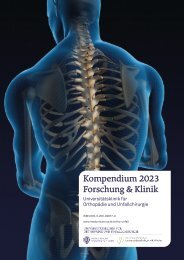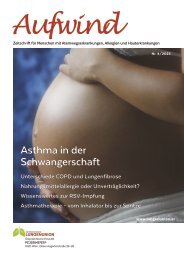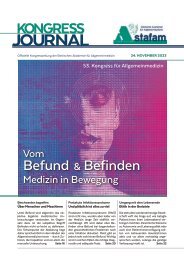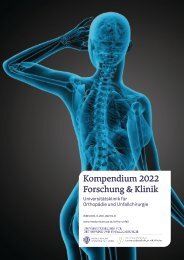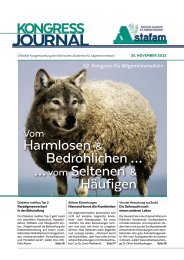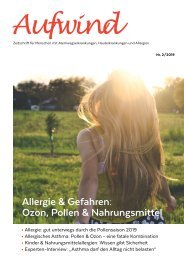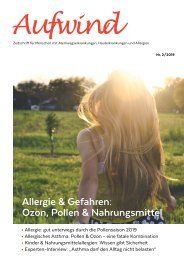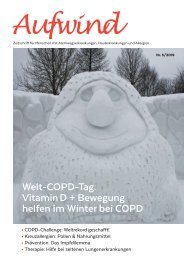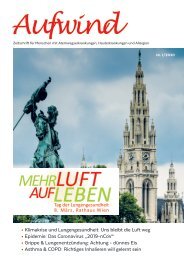Kompendium 2020 Forschung & Klinik
Das Kompendium 2020 der Universitätsklinik für Orthopädie und Unfallchirurgie von MedUni Wien und AKH Wien (o. Univ.-Prof. R. Windhager) stellt einen umfassenden Überblick über die medizinsichen Leistungen und auch die umfangreichen Forschungsfelder dar. Die Veröffentlichungen zeigen die klinische Relevanz und innovative Ansätze der einzelnen Forschungsrichtungen. Herausgeber: Universitätsklinik für Orthopädie und Unfallchirurgie MedUni Wien und AKH Wien Prof. Dr. R. Windhager ISBN 978-3-200-07715-7
Das Kompendium 2020 der Universitätsklinik für Orthopädie und Unfallchirurgie von MedUni Wien und AKH Wien (o. Univ.-Prof. R. Windhager) stellt einen umfassenden Überblick über die medizinsichen Leistungen und auch die umfangreichen Forschungsfelder dar. Die Veröffentlichungen zeigen die klinische Relevanz und innovative Ansätze der einzelnen Forschungsrichtungen.
Herausgeber: Universitätsklinik für Orthopädie und Unfallchirurgie
MedUni Wien und AKH Wien
Prof. Dr. R. Windhager
ISBN 978-3-200-07715-7
You also want an ePaper? Increase the reach of your titles
YUMPU automatically turns print PDFs into web optimized ePapers that Google loves.
TOP-Studien<br />
30<br />
Rheumatoid Arthritis Disease<br />
Activity and the Risk of Aseptic<br />
Arthroplasty Loosening<br />
Rheumatoid arthritis (RA) is characterised by typical joint inflammation<br />
and synovitis, which, if not treated effectively, leads to joint<br />
destruction and functional disability. Although new treatment<br />
strategies improved long-term outcomes tremendously, rates of<br />
total hip and knee arthroplasty (THA/TKA) in patients with RA<br />
remain considerable.<br />
As RA differs fundamentally from osteoarthrosis (OA) in terms of prognosis,<br />
pathogenesis, and medical treatment, outcomes of total joint arthroplasty<br />
(TJA) and rates of complications would be expected to be different between<br />
these two diseases. Aseptic loosening is the most common cause for surgical<br />
revision after TJA with far-reaching implications, including an exchange of the<br />
implant associated with decreased function, loss of bone stock and an increased<br />
risk for further complications. Reasons for aseptic loosening are not<br />
fully understood, but local inflammation is suspected to play a crucial role.<br />
Systemic inflammation in RA might influence this process of local inflammatory-mediated<br />
osteolysis and could lead to higher aseptic loosening rates<br />
in RA patients, especially in those with increased inflammatory activity. The<br />
objective of this study was to assess the influence of RA disease activity on<br />
the risk of aseptic loosening after TJA. Furthermore, we evaluated if antirheumatic<br />
therapy has an influence on the risk of aseptic loosening. Additionally,<br />
we analysed the rates of radiographic aseptic loosening in OA patients, as a<br />
control group without systemic inflammation.<br />
Study:<br />
Böhler C, Weimann P, Alasti F,<br />
Smolen JS, Windhager R, Aletaha<br />
D. Rheumatoid arthritis<br />
disease activity and the risk of<br />
aseptic arthroplasty loosening.<br />
Semin Arthritis Rheum. <strong>2020</strong><br />
Apr; 50(2):245–251<br />
Patients and Methods<br />
We ascertained data of 49 RA patients who underwent primary TJA with a<br />
fully documented disease activity as well as a complete clinical and radiological<br />
follow-up for analysis. Further we investigated a cohort of OA patient,<br />
who were matched 2:1 for sex, age, date of surgery, and location of TJA as a<br />
control group without systemic inflammation. We obtained demographic data,<br />
comorbidities, antirheumatic therapy results, clinical and functional scores,<br />
duration of surgery, and the type of implant. Due to the restricted number of<br />
revision surgery because of aseptic loosening, we used radiological signs of<br />
component loosening (RCL) as a more sensitive surrogate outcome parameter<br />
for our main analysis. These included radiolucent lines (RLL) with a width<br />
of ≥2mm, osteolysis exceeding 2mm in thickness, and implant migration of<br />
≥2mm. Two independent observers, who were blinded for levels of disease ac-




